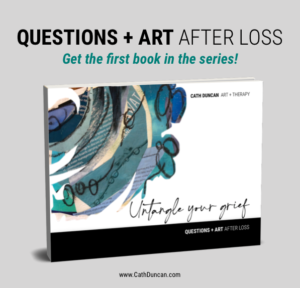I created this collage and wrote the notes for it on 17 January 2011. At the time I was still struggling with fatigue, which we later discovered was caused by the medication I was on. I was probably also just physically and emotionally exhausted after all I’d been through over the past 8 months.
Having supported so many other people through their grieving, I knew that the groundlessness and the lack of meaning and hope for the future that I felt were all normal feelings, but I really found it hard to relax into. I’ve always been a very proactive, motivated and purposeful person and a planner who likes to look to the future, prepare and feel in control, so my lack of future vision made me feel both anxious and worthless.
With my physical and mental fatigue, I found it difficult to even do anything proactive like working with someone to begin creating a new vision. And looking back now, I think it would have been too soon for that anyway. I wasn’t ready for opening my heart to new likes and loves – I was too afraid of losing it, so I wouldn’t have been able to find any likes or loves on which to begin building a new vision at that stage. I needed to rest first, to take care of my physical health and resolve my fatigue, and I needed to allow the grieving.
At first I had the idea to “work on” my grief. I thought this would make it go faster so I could get out of the groundless grieving space I was in sooner. But grief comes in waves and we can’t sustain feeling it for a very long time. Grief has it’s own schedule and it can’t be rushed. When we try to rush it or skip it, we only cause more damage.
So I would do a little bit of reflecting, feeling, talking or crying each day, and pass the rest of the day making puzzles, taking short walks and sleeping. I bought a large 2000-piece puzzle with a print of Vincent Van Gogh’s Starry Night – one of my favorite paintings, and I would sit in silence, hypnotized by colors and shapes that were so small that they meant nothing to my left brain. It took me about 4 months of steady work to complete the puzzle. Sometimes Andy or others would join me and we’d sit together in silence or chatting as we worked together to build the picture. I found this very calming.
At some point the metaphor of what I was doing while I built my puzzle dawned on me. My life after losing Juggernaut reflected the puzzle-building process. I had a pile of pieces before me – each too small to be able to “figure out” or understand on it’s own. I had to trust that there’s a bigger picture – one where the pieces somehow join up. The pieces weren’t going to join up by themselves – I had to get in there and try, discover, adapt, try another… until they joined up bit by bit. I had to relax into it, recognizing that it’s going to take some time to build the picture and that impatience would not make it go faster. And when I relaxed into it, I actually enjoyed the process.
You can see my impatience and frustration in the piece I wrote below. But you can also see a sense of hope and a sense of faith that the pieces would eventually come together to form some pleasing vision. My collage helped me to integrate these insights I’d had about the puzzle-making nature of life after loss, and to affirm my trust in the process, and I began to believe that, on some level, while I built my puzzle in my living room, in other less tangible realms (inside my heart, my unconscious mind, and the world at large), the pieces of my new life vision and sense of self were coming together too.
Of course those of you who are familiar with ideas on left- and right-brained problem-solving will notice that art-making and puzzle-making are both activities that invite right-brained thinking. Loss can’t be “figured out,” so left-brained thinking becomes completely stumped. We need to employ huge amounts of creativity just to find a reason to get out of bed after a significant loss – nevermind everything else involved in creating a meaningful life. Right-brained activities like art-making and puzzle-making (especially when the pieces are so small that the design on them becomes meaningless) are really useful activities for helping your brain let your right-brained thinking strategies come to the fore.
I had a picture, a vision, a dream. That got shattered and I’m left with all the bits. They don’t fit together the way I had hoped they would, and some pieces are gone forever. I don’t see – I can’t imagine – creating a new picture out of this… these pieces I’m left with. And I don’t know where to start.
And yet I must start anyway. And I must believe that one day I’ll see a new picture emerging – a picture I can get excited about. A picture that will inspire me and give me reason to keep working at it, joining up and creating, learning and being alive.
I wish I at least knew what picture I’m working towards as I sit here with all these stray pieces.



I lost my husband 3 years ago and our family has struggled with several health issues since then. Your comments on right brain problem solving coming to the forefront make a lot of sense. And your descriptions of how your life feels after a traumatic loss ring so true in terms of trying to piece it all back together.
Thanks!!
My pleasure, Lyneve… big love to you and your family.